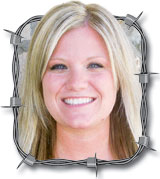I love this time of year, but not for the obvious. Yes, the cooling of the weather and the changing of the leaves is nice, but the part I like is going to the mailbox and opening at least one purebred auction catalog every single day. Some days there are more than one.
I don’t raise purebred livestock anymore, but the 14 years that my sons bought, showed, bred and raised registered beef cattle evidently put us on every mailing list in the United States. I miss those times where we got to travel often and meet some of the finest people in the world, not to mention spending a lot of quality time with the boys. Plus, I have always admired high quality animals and I consider it both an art and a science to consistently produce champions. The people who work so hard to improve the genetics of any species have my utmost respect.
Zach, our youngest, was home from college this past weekend and picked up a copy of one of the catalogs and was thumbing through it while he ate supper. “There she is!” he exclaimed as he discovered a picture of the dam of one of the show heifer lots offered for sale. This cow would have to be about ten or 11 years old now, but she was Zach’s choice for a show heifer one year when we attended a sale in Indiana.
We had been traveling to this farm’s annual production sale for several years and always found a high quality heifer to purchase. We would always get there the evening before the sale and I would let Zach spend a couple of hours walking through the pens and he would write down his top five animals, in order, and I would try to purchase the highest of his selections that I could afford. This year, however, his first choice was the finest beef female I had ever laid eyes on. I told Zach that we would try, but I suspected she would go much higher than a 12-year-old boy could afford. Even to this day, when I’m judging a cattle show, it is this female that I have in my mind as the ideal. There was not one thing that I would have changed about the individual – and that went against my lifetime creed of, “The perfect animal doesn’t exist.”
The next day, Zach and I got there early in order to get a good second row seat (you never want to sit on the front row at a cow sale). The aforementioned heifer was the first one in the ring, selling as lot No. 1. The bidding was fast and furious as many people had the same opinion of the heifer as did Zach and I. I could tell that Zach had the adrenaline flowing as he was on the edge of his seat, eyes as wide as silver dollars, and I thought I could detect a little perspiration on his upper lip. The bidding began to stall somewhat around $35,000.00. The experienced old auctioneer took that opportunity to quiet and let the pedigree reader reinforce the fact that with embryo transfer and other scientific advancements, this was way too cheap for a female with this bloodline and conformation. Zach tugged on my shirt sleeve and asked, “Are we still in, Dad?”
“Son,” I replied gently, “We have never been IN on this little heifer.” Knowing that he sometimes had trouble understanding the auctioneer’s chant, I asked, “Do you know where the bidding is right now?”
“Thirty-seven hundred, right?”
“No,” I answered, “it’s thirty-seven thousand!” His wide eyes got even wider.
Bidding resumed and the outstanding heifer eventually sold for $60,000.00 and I still believe it was a bargain for the buyer. She went on to win the national championship for that breed the next year and I’ll bet her offspring have sold for close to a million in the years following. We ended up buying Zach’s third choice for a small fraction of the high seller and I doubt that my son would have learned any more or had any more fun than he did with his much cheaper purchase.
The other night, as Zach thumbed through the catalog and identified that “perfect” cow that he had selected nine years ago, I had to ask, “Son, were you disappointed that we weren’t able to buy that heifer back then?”
“Nah,” he answered thoughtfully. “I was disappointed, though, to find out that we were poor.”
Jerry Crownover farms in Lawrence County. He is a former professor of Agriculture Education at Missouri State University, and is an author and professional speaker. To contact Jerry, go to www.ozarksfn.com and click on 'Contact Us.'






